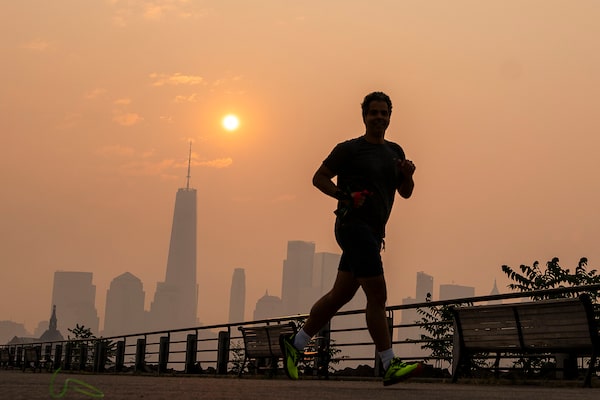
Brian Gallant congratulates a runner at the finish line of the 2021 edition of the Black Spur Ultra, at the Kimberley Alpine Resort, in Kimberley, B.C.Handout
Last August, as wildfires burned throughout much of western Canada, Brian Gallant’s phone began ringing off the hook. With B.C. having just declared a state of emergency, runners were eager to know whether Mr. Gallant’s company, Sinister Sports, would still be holding the ultra-marathon it had planned to host in just a few days.
“We had tons of people contacting us – ’What’s happening? Is the race continuing? What are you going to do?’” Mr. Gallant says.
Amidst all the uncertainty and concern, the race was able to go ahead.
“The question of whether or not we can combat climate change is kind of irrelevant. Right now I’m more focused on how do we live with it?” says Mr. Gallant, who has owned the adventure sports company since 2002. “Back, you know, 20 years ago when we started doing this, smoke was a very, very rare thing. And now your whole summer can be punctuated with smoke days.”
Fall’s cooler temperatures are embraced by the many runners who will participate in the marathons that fill the month of October across Canada. Race directors are happy to see a brutal summer behind them. But climate change, and its impact on the future of marathons, ultra-marathons and extreme events such as those operated by Tough Mudder, is very much on the minds of race directors who are adjusting with new policies and practices while acknowledging there is only so much they can do in the face of rapid, often unpredictable weather events.
In June, the Ironman 70.3 event in Mont Tremblant and the Groupe Copley World Triathlon in Montreal were cancelled because of poor air quality caused by the 80 wildfires that were active in Quebec.
In August, an Ironman triathlon event in Penticton, B.C., the first since the pandemic, had to be cancelled because of a provincial restriction on non-essential travel in response to forest fires.
It was just the latest Ironman event to be cancelled because of factors related to climate change. In 2018, an Ironman race in Germany had to cancel the swim portion of the triathlon because of high levels of toxic blue-green algae that had spread as a result of Europe’s heat wave. That same year, Hurricane Florence forced the cancellation of an Ironman in North Carolina and a few months later another hurricane compelled Ironman to change the date and location of a race in Florida.

A man jogs through Liberty State Park while smoke from wildfires in Canada covers the Manhattan borough, on June 8.Eduardo Munoz Alvarez/Getty Images
Forest fires in particular require race operators to be more nimble than ever, says Keats McGonigal, Ironman’s vice-president of operations.
“The interesting thing about our particular events is they take place over a large geographic area. When you’re talking about a bike course that is 180 kilometres long you can have good air quality in one location and bad air quality and another so you know, we’re looking at co-ordinating with the local officials and getting as much real-time data as we can.”
Real-time data might allow race directors to adjust race routes, directing athletes away from areas of poor air quality, but there is little that can be done in the face of extreme heat, as organizers of the Manitoba Marathon realized in 2022.
The temperature was 23 C when runners crossed the starting line at 7 a.m. But race organizers were forced to cancel the event approximately 75 minutes later when Environment Canada issued a heat warning.
Rising temperatures were likely also a factor in a bacterial outbreak at a Tough Mudder event in northern California in August with more than 100 participants reporting fevers, vomiting and a pustular rash after running and crawling through a muddy obstacle course.
“Warmer temperatures might help bacteria to grow at higher levels. The same could be said for many different bacteria that could cause gastrointestinal illness,” says Ian Young, a professor at Toronto Metropolitan University who specializes in recreational water-borne illness. “And then the other factor, there is extreme weather events. With climate change, we know that we have more severe rainstorms that could be leading to more flooding. And those events are what can really move pathogens around.”
Moving events from the summer to the spring or fall isn’t really an option for many race organizers who are dealing with an already crowded calendar, Mr. Gallant says.
“Most of our events are on the bigger side. So if we decide to move, our dates are going to inevitably squish somebody else. And that’s not what we want to do,” he says.
Besides, some events that have participants running at high elevations through a race simply couldn’t be held in the spring or fall, says Adrian Lambert, president of the Canadian Trail and Mountain Running Association.
“Once you get up about 1,000 metres, there’s going be snow pretty much everywhere in Canada through the end of April and you could easily get snow in October. So you actually have a narrow window,” he says.
Instead of moving dates, races will have to adopt clear policies – as Sinister Sports did this past year with a new air quality policy – that set out when races will have to be cancelled because of air quality, temperatures or other such factors, Mr. Gallant says.
Once those policies are in place, race directors may have little else to do but hope for clear skies and cool temperatures.
“Nobody can predict exactly what the weather in Penticton will look like next August, so we’re making plans to move forward with the event,” Mr. McGonigal says of Ironman’s intention to resume its triathlon in B.C. in 2024. “We’ll respond accordingly based on what cards we’re dealt on that particular weekend.”
 Dave McGinn
Dave McGinn